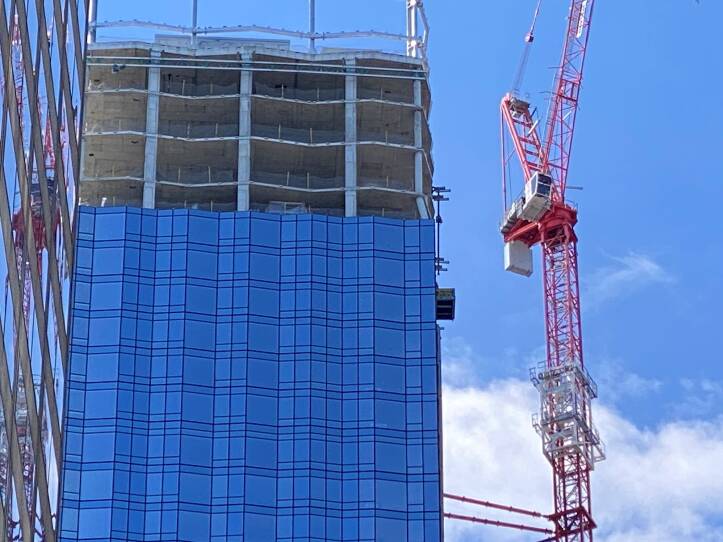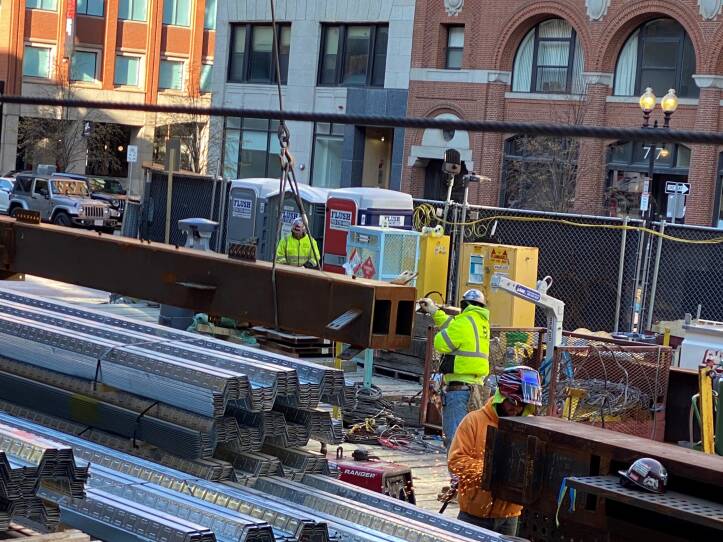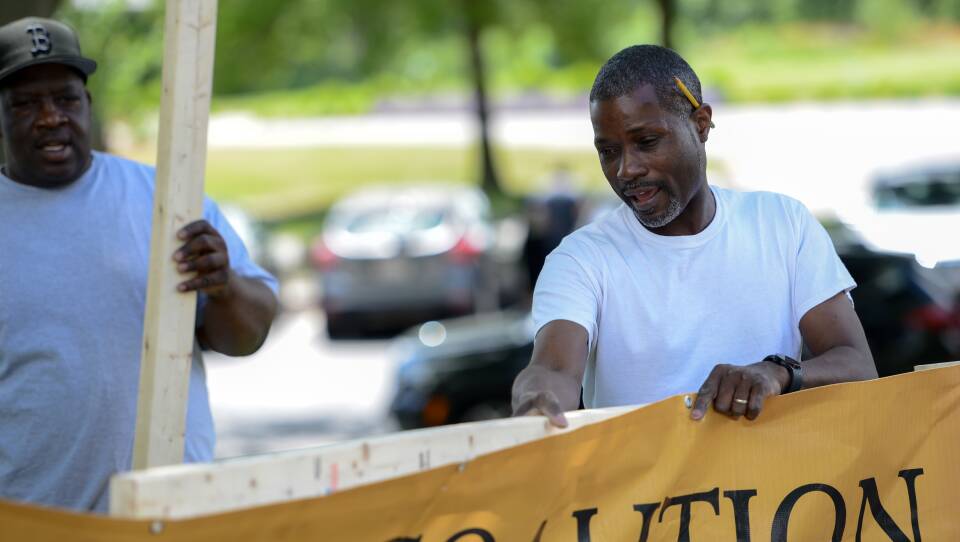When Jamie Wallace became an industrial glass worker in 1995, he says he was one of six Black members of a 300-person local union.
Now, the 50-year-old veteran glazier from Roslindale estimates he’s one of about 30 Black members in the Boston-area union that has nearly doubled in size — an increase of less than one Black member a year. Wallace says the lack of diversity is a sign of a wider problem in the trades: Boston-area unions are not doing enough to bring in workers of color.
“It's the good old boys club,” he said. “They know they are falling short. … Of course they know.”
The union declined to comment on Wallace’s concerns, and would neither confirm nor dispute his numbers.
In May, after years of organizing, Wallace was granted a charter to relaunch the Boston chapter of the national Coalition of Black Trade Unionists. The original chapter petered out about 15 years ago. The chapter’s goal, Wallace says, “is to see that Black men and women get gainful employment through their prospective local unions in the building trades.” But that mission is rife with challenges.
The Boston population has grown increasingly diverse over the past few decades, with people of color accounting for more than half of the city's current residents and Black people making up 24% of all residents. But the city's construction workforce has not kept pace, according to Boston city data compiled and analyzed by the GBH News Center for Investigative Reporting.
The workforce on major construction projects was about 63% white in 2021, according to data collected by the city's Boston Residents Jobs Policy office. While this is lower than ten years ago — when white workers accounted for 72% of the workforce — almost all of the change has been made up by a growth in Hispanic workers. The Black workforce on major construction projects has hovered between 12% and 14% every year since 2012, according to city data.
More Local News
The data also shows a kind of caste system in construction. The higher up you go in a building under construction, the less likely you are to find workers of color.
For example, on large Boston projects, 89% of elevator construction work hours were performed by white people last year, as were 88% of equipment operator hours, according to city data. The glaziers who install windows in skyscrapers were 76% white. A worker up in a crane almost certainly is a white man: The city’s data indicates that from 2017 through 2020, 88% of the 12,000 hours listed as “crane operator” were worked by a white person, and none were worked by women.
Closer to the ground, where jobs are often lower paid and more hazardous, there are more workers of color. Only 55% of laborers on construction sites, who handle a lot of demolition and site cleanup work, were white people last year. Asbestos workers, a notoriously hot and dangerous speciality, were 75% people of color each of the past three years, and the bulk of those workers were Hispanic.
Segun Idowu, the city’s new chief of economic opportunity and inclusion, told GBH News he is concerned about the slow pace of change in the building trades.
“This continued system where people of color, women, those who are the most disadvantaged continue to grow at a very small or slow pace and continue to be kept from being able to get more lucrative opportunities is bothersome to us and remains and will always be a key focus of ours,” he said.
Wallace, who carries a copy of the anti-racist book “White Fragility” in his tool bag, says the trades reflect the same structural racism that permeates other parts of American culture.
GBH News interviewed a dozen Black tradesmen who shared stories about being called the “N word” on the job or having coworkers make sexual and racial jokes. They detailed having to choose between confronting racism and being labeled “the angry Black guy.” None of these men were willing to share their stories or their names on the record, for fear that the unions could punish them for speaking out.
Wallace said he has seen white workers leave a noose in the lunchroom for a Black worker. “We know systemic racism is constant, and it's always been — always has been, always will be — in this country,” he said.
Winthrop Center misses its mark
Consider the case of the Winthrop Center, a gleaming glass tower rising in the heart of Boston’s Financial District that was supposed to set new heights in minority inclusion.
In 2016, New York developer Millennium Partners won a heated competition to buy the land from the city and then signed an agreement to meet Boston’s workforce diversity goals: 51% Boston residents, 40% people of color and 12% women.
But in April of this year, Millennium Partners issued a report showing that of the 750,000 hours of work performed on the 53-story tower, only 31% were performed by people of color. That’s the exact same figure achieved by the highest-performing construction projects in 1987, according to a survey conducted at the time by the Boston Globe.

Kathleen MacNeil, a principal at Millennium Partners Boston, told GBH News the developer wanted the building to be a model of workforce inclusion. The company and its general contractor, Suffolk Construction, signed a deal with the Building and Construction Trades Council — an umbrella group of two dozen major construction unions — to deploy a workforce that met city diversity targets.
MacNeil said it was the first time her firm wrote those targets into a union labor agreement. “We really felt it’s time for our jobs to reflect the city of Boston,” she said. And the complexity of building a massive downtown tower means they can’t hire workers off the street — they needed union-trained workers who could handle a highly technical project.
But the goals haven’t been met, and Millennium Partners and Suffolk point to the unions.
“We get assigned a workforce out of the union hall,” said Nick Dhimitri, a senior vice president at Suffolk Construction. “The limiting factor on our ability to deliver diversity is tied directly to how diverse or not the union hall is.”
MacNeil said she doesn’t know whether the unions have a workforce that is diverse enough to meet the goals. “Finding out what's in the union hall has been a challenge for me,” she said.
She’s not alone.
For three months, GBH News has been asking the Building Trades Council for data on the diversity of union membership, but has not received a response. The council, through a spokesman, declined to provide GBH News demographic data. The elevator union, the equipment operators union and others did not respond to GBH News requests for comment or data.
Members of the Boston Employment Commission also have complained that they cannot get demographic data from the unions, making it impossible to say whether there are enough minority workers in the union halls for builders to meet the city’s hiring goals.
Wallace says he believes his union knows how many Black members there are, but is purposefully withholding the information. “They don't want to be held accountable and put the blame on themselves,” he said.
"They don't want to be held accountable and put the blame on themselves."Jamie Wallace, president of the Boston chapter of the Coalition of Black Trade Unionists
The federal Equal Employment Opportunity Commission does have one limited set of data that suggests how segregated local unions are. The agency collects data on some large “referral unions” — those that dispatch workers to a job site at the request of a general contractor. In 2018, 23 Massachusetts unions filed data into this system, though there is no way to know which unions. In total, those unions reported having 19,335 members, 86% of whom were white, 5% Black and 7% Hispanic. Statewide, the 2020 census showed Massachusetts was about 70% white, 9% Black and 12% Hispanic.
Union advocates say it is unfair to blame the unions for the slow growth of the minority workforce on Boston construction projects. The city data GBH News analyzed combines union and non-union projects, so union efforts to recruit and deploy a more diverse workforce may be masked by non-union shops that are not making the same effort. And unions don’t actually employ the workers; they are the employees of private companies, who control who gets hired.
Others are more critical. Mukiya Baker-Gomez, a consultant for the Dorchester-based Black Economic Justice Institute Inc., says any contractor trying to deploy union labor has to work through the unions to get people assigned to them, so the unions could be driving more diversity if they wanted to. The unions "absolutely have direct influence over every single contractor that's a member of their union," she said.
After decades of organizing and efforts by the Black community to get more people into the building trades, Baker-Gomez said, “There's no way in the world the numbers should be where they are right now.”
Unions push back
At a July meeting with GBH News convened by Building Pathways, the unions’ pre-apprenticeship program, several union members of color rejected the notion that unions are a barrier to people of color.
Chaton Green, a Black member of the sprinkler fitters union, says unions are the solution to racism in the construction trade, not the problem, and he says the union has been a positive force for him and his community in Roxbury. “We live in these neighborhoods that we work in. I can walk home from here right now," he said. "And the union has afforded me a wonderful life.” He said many people in his community have followed the same path, and succeeded.

Green and other union workers say that apprenticeships are the only path into the trades that the unions control. The other entry point is through a private construction company. When workers organize and join a union, the union absorbs them, regardless of racial makeup. Many of those workers stay for decades.
“It could be 10, 20, 30 years,’’ that those workers stay on the job, Green said. “So those numbers are going to look like whatever shop we organize.”
He said the union apprenticeship programs show how seriously unions are trying to diversify, and city data show progress in his trade. While sprinklerfitter hours in the city’s construction database were 73% white in 2021, the Black share of those hours was 15% — up from only 4% a decade ago.
Renee Dozier, a Black woman and union electrician who came up through the apprentice program 20 years ago, is now a business agent for her local. She says her union, the International Brotherhood of Electrical Workers Local 103, has made extraordinary strides to include women and people of color — efforts that are not being matched by non-union companies.
Dozier acknowledges that she has dealt with her share of “jerks,” but also worked with many colleagues who accepted and supported her. She describes the union as a family. “We’ve made so much progress,’’ she said. “I’m proud to watch it grow, and I’m going to water it and keep planting seeds.”
In June, Dozier’s union announced that it was enrolling “the most diverse first-year electrical and telecommunications [apprentice] class in the history of the union,” with women and people of color making up about 50% of the nearly 450 new trainees.
It is clear from state data that unions are doing the bulk of the training for apprentices of color. Massachusetts buidling trade unions trained 6,800 apprentices in 2020, and about 30% were people of color, according to data provided to GBH News by the Massachusetts Department of Labor. In contrast, non-union shops trained 1,700 apprentices and about 20% were people of color, data show.
"We've made so much progress. I'm proud to watch it grow, and I'm going to water it and keep planting seeds."Renee Dozier, business agent for International Brotherhood of Electrical Workers Local 103
So why aren't those diverse training classes reflected in a more diverse workforce?
Not every apprenticeship leads to a good job and change in the workforce. Apprenticeships can take up to four years, and, like college, can be challenging for trainees who do not have financial or social support. Once workers complete their apprenticeship, there is no guarantee that they will get enough work hours to support themselves and their family on the job site.
Some other cities, like Denver, are experimenting with programs that directly support apprentices with assistance ranging from boots to transportation costs to job placement.
“We often talk about how we recruit diverse populations,” said Derrick Watson, who runs the Denver Construction Careers Program. “But, you know, recruiting them and graduating them are two different things.” Denver is also testing a requirement that builders use a certain percentage of apprentices on major construction projects; Boston does not have a similar requirement.
Jamie Wallace says some people of color may simply realize once they start pursuing a job that it just “is not for them” so they drop out. But “there are others that the atmosphere is so tense that it drives them away,” he said.
The federal government has taken notice of this problem nationwide. The passage last year of a $1.2 trillion infrastructure bill means that Massachusetts and other states around the country are poised to see billions of dollars of new construction projects with potentially millions of new construction jobs . The federal Equal Employment Opportunity Commission is very concerned that women and people of color get a fair share of those workhours, and held a hearing in May called “Knocking Down Walls: Discrimination and Harassment in Construction.”
“The construction industry up until 1970 was just basically closed and it was all about white men,” EEOC Associate Legal Counsel Sharyn Tejani told GBH News. And while activism, organizing and protests have opened the doors to people of color in the construction trades, “the numbers are improving very, very slowly,” she said.

Part of the problem, Tejani said, is that “even as you push people through and even as people get hired, then they don't stay.” And what the commission has learned is that “one of the big reasons that black and brown people and women don't stay is discrimination and harassment,” she said.
Wallace is hopeful that Boston’s trade unions will welcome him and the Coalition of Black Trade Unionists as partners to build a more diverse workforce. He wants the local unions to introduce their members to his organization, and he wants to take his people into schools and job fairs to recruit more young people of color into the trades.
He is confident that history is on his side. “The door will start to open up a little more and things will start to level out” as older union members retire, he said. “The new generation is starting to come up.”
Reporter Chris Burrell and intern Emma Foehringer Merchant of the GBH News Center for Investigative Reporting contributed reporting for this story, and Boston University graduate student Chen Wu provided data analysis. This story originated from conversations with Boston Black News .








